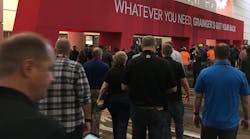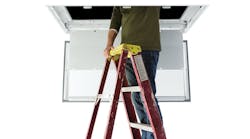2018 Grainger Show Highlights the Company’s Continuing Progression
At the 14th annual Grainger Show, held February 11 to February 13 in Orlando, Fla., the company highlighted its MRO offerings for the safety market; its disaster recovery efforts in response to the recent hurricanes and fires; its growing emphasis on digital commerce; and the new inventory management services it’s offering end-users. An estimated 12,000 of the company’s customers, vendors, and employees filled a chunk of Orlando’s Orange County Convention Center, while 700 exhibitors shared the 450,000-sq-ft show floor. Some of those customers were electrical contractors. It’s estimated the Lake Forest, Ill.-based company has $1 billion-plus in annual sales of electrical equipment and related job-site supplies to electrical contractors and facility maintenance personnel.
An abundance of familiar brands filled the show aisles, including electrical lines like Acuity, Current by GE, Eaton, Fulham, Hubbell, Ideal Industries, Philips Lighting, Schneider, Siemens, Shat-R-Shield, Milwaukee Tool, DeWalt, and Bosch. In addition to these brands, the company also displayed its well-known private labeled products, including Dayton motors and HVAC equipment, and LumaPro lighting products that are part of its GC Choice program. Currently, the company privately labels thousands of products under its Grainger Choice brand, including 215,000 products in more than 32 categories, such as HVAC and refrigeration, material handling, safety, cleaning, pneumatics, motors, hand tools, and electrical.
In addition to exploring the numerous new products on display at the show, the 5,000-plus contractors and facility maintenance personnel in attendance also received the opportunity to learn more about the company’s online ordering options, which now account for more than 60% of its total annual business and the growing array of its KeepStock inventory management services. Through KeepStock, Grainger’s customers can stock and manage inventory in their facilities through several different types of vending machines loaded with MRO replacement supplies; tool-crib management programs; and, for the largest customers, even with the help of a full-time Grainger inventory and logistics expert. The KeepStock vending machine program, tool crib replenishment, and Managed MRO programs are now integrated and strive to give customers consistent digital touch points.
Many contractors and facility maintenance personnel know Grainger through its giant red catalog or the company’s website, which was one of the first online purchasing options offered by an industrial distributor.
To keep up with customers’ evolving purchasing habits, which have swung strongly to online shopping, Grainger majorly modified its service offerings and branch network. In fact, over the past 10 years, the company has reduced the number of its U.S. branches from 411 in 2006 to 254 in 2016, according to its Factbook, and orders originating at branches account for just 11% of its total sales. Eighty-five percent of its orders are delivered directly to customers and not picked up at the branches. In addition to the nearly one-third of orders it receives digitally, the company says 22% of orders originate over the telephone — many through its three national call centers or the inside sales operations it opened in San Antonio in 2016.
To fend off companies like Amazon and other online competitors, Grainger has made significant investments in digital operations. According to numerous reports, Amazon has taken direct aim at Grainger’s MRO business with its Amazon Business (formerly AmazonSupply.com). Grainger also tweaked its pricing structure in mid-year 2017 to attract more medium-sized customers (companies spending $10,000 to $60,000 annually on MRO) with lower prices. Grainger CEO D.G. MacPherson told business editors at the show’s Media Roundtable that traffic from these mid-sized customers at the company’s branches is up after last year’s pricing modifications. An article on www.digitalcommerce360.com said Grainger first adjusted its online pricing down about 4% for 400,000 stock-keeping units (SKUs) — approximately 25% to 30% of its total SKUs — and rolled out price cuts to all its online SKUs throughout 2017. So far, signs indicate the changes to the pricing structure and the other strategies mentioned earlier are working.







